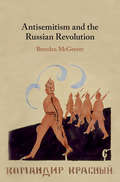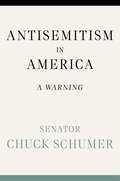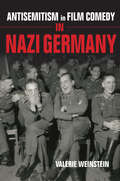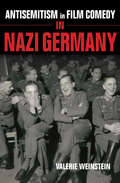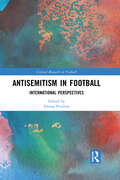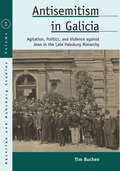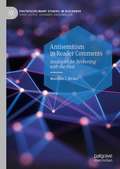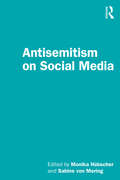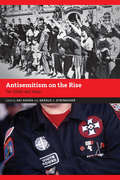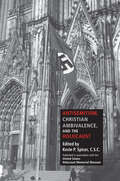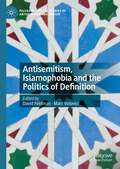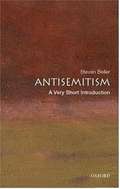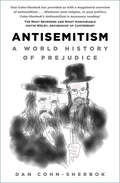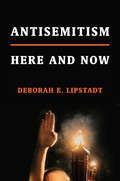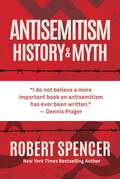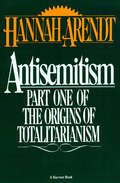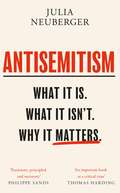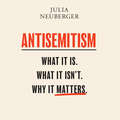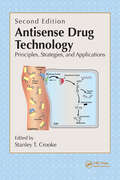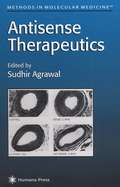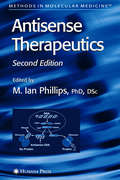- Table View
- List View
Antisemitism and the Russian Revolution
by Brendan McGeeverWhen the Bolsheviks came to power in 1917, they announced the overthrow of a world scarred by exploitation and domination. In the very moment of revolution, these sentiments were put to the test as antisemitic pogroms swept the former Pale of Settlement. The pogroms posed fundamental questions of the Bolshevik project, revealing the depth of antisemitism within sections of the working class, peasantry and Red Army. Antisemitism and the Russian Revolution offers the first book-length analysis of the Bolshevik response to antisemitism. Contrary to existing understandings, it reveals this campaign to have been led not by the Party leadership, as is often assumed, but by a loosely connected group of radicals who mobilized around a Jewish political subjectivity. By examining pogroms committed by the Red Army, Brendan McGeever also uncovers the explosive overlap between revolutionary politics and antisemitism, and the capacity for class to become racialized in a moment of crisis.
Antisemitism in America: A Warning
by Chuck SchumerIn an urgent and personal new book, Democratic Leader Chuck Schumer, the highest-elected Jewish official in America, sheds light on the Jewish American experience and sounds the alarm about the troubling resurgence of antisemitism. <p> For the first time in generations, antisemitism has become a daily reality in America, and it’s getting worse. Jewish synagogues and their congregants are targeted and sometimes killed by extremists, Jewish students are harassed and attacked on campus, conspiracy theories about Jews have gone mainstream on social media, and debates over Israel have veered into dangerous territory. <p> Senator Chuck Schumer tackles the historical, political, cultural, and international forces that have led to the alarming rise of antisemitism in America in the 21st Century. ANTISEMITISM IN AMERICA: A WARNING is a timely work of nonfiction that illuminates his generation’s Jewish experience. From Brooklyn in the 1960s to Harvard in the 1970s to the inside of a secure bunker on January 6, 2021, Schumer takes readers on a personal journey of how Jewish Americans like him have come to understand their history, their place in America—and why they worry about the future of Jewish life in America. This book is a warning, informed by the lessons of history, about what can happen when the world’s oldest hatred is allowed to rise unchecked. <b>New York Times Bestseller</b>
Antisemitism in Film Comedy in Nazi Germany
by Valerie WeinsteinToday many Germans remain nostalgic about "classic" film comedies created during the 1930s, viewing them as a part of the Nazi era that was not tainted with antisemitism. In Antisemitism in Film Comedy in Nazi Germany, Valerie Weinstein scrutinizes these comic productions and demonstrates that film comedy, despite its innocent appearance, was a critical component in the effort to separate "Jews" from "Germans" physically, economically, and artistically. Weinstein highlights how the German propaganda ministry used directives, pre- and post-production censorship, financial incentives, and influence over film critics and their judgments to replace Jewish "wit" with a slower, simpler, and more direct German "humor" that affirmed values that the Nazis associated with the Aryan race. Through contextualized analyses of historical documents and individual films, Weinstein reveals how humor, coded hints and traces, absences, and substitutes in Third Reich film comedy helped spectators imagine an abstract "Jewishness" and a "German" identity and community free from the former. As resurgent populist nationalism and overt racism continue to grow around the world today, Weinstein’s study helps us rethink racism and prejudice in popular culture and reconceptualize the relationships between film humor, national identity, and race.
Antisemitism in Film Comedy in Nazi Germany (Encounters: Explorations in Folklore and Ethnomusicology)
by Valerie WeinsteinHow party propagandists worked behind the scenes to create unspoken racist messages in the German culture—even in the most lighthearted of movies. Today many Germans look back fondly on 1930s film comedies, viewing them as a part of the Nazi era that was not tainted with antisemitism. Here, Valerie Weinstein scrutinizes these comic productions and demonstrates that film comedy, despite its innocent appearance, was a critical component in the effort to separate &“Jews&” from &“Germans&” physically, economically, and artistically. Weinstein highlights how the German propaganda ministry used directives, pre- and post-production censorship, financial incentives, and influence over film critics and their judgments to replace Jewish &“wit&” with a slower, simpler, and more direct German &“humor&” that affirmed values that the Nazis associated with the Aryan race. Through contextualized analyses of historical documents and individual films, Weinstein reveals how humor, coded hints and traces, absences, and substitutes in Third Reich film comedy helped spectators imagine an abstract &“Jewishness&” and a &“German&” identity and community free from the former. As resurgent populist nationalism and overt racism continue to grow around the world today, Weinstein&’s study helps us rethink racism and prejudice in popular culture and reconceptualize the relationships between film, humor, national identity, and race.
Antisemitism in Football: International Perspectives (Critical Research in Football)
by Emma PoultonThis book investigates the nature and prevalence of expressions of antisemitism within the context of football in Europe and beyond, as well as attempts to challenge and combat this problematic phenomenon. Drawing on empirical research, the book presents a series of case studies of countries in which both football and antisemitism have been prominent, including England, Italy, Germany, Holland, Poland, Argentina and Hungary. Each chapter explains the historical context of why antisemitism prevails in their country and their country’s football culture; considers those football clubs with a ‘Jewish’ heritage and identity (which tend to be the catalyst for antisemitic abuse); and critically examines the measures being taken in that country to tackle antisemitism in football by organisations including governing bodies, campaign groups, supporter groups and football clubs themselves. No other book has looked as deeply into this highly topical issue which continues to blight contemporary football. Antisemitism in Football is important reading for anybody with an interest in football, fan cultures, the sociology of sport, Jewish studies, antisemitism and other forms of racism and discrimination in society.
Antisemitism in Galicia: Agitation, Politics, and Violence against Jews in the Late Habsburg Monarchy (Austrian and Habsburg Studies #29)
by Tim BuchenIn the last third of the nineteenth century, the discourse on the “Jewish question” in the Habsburg crownlands of Galicia changed fundamentally, as clerical and populist politicians emerged to denounce the Jewish assimilation and citizenship. This pioneering study investigates the interaction of agitation, violence, and politics against Jews on the periphery of the Danube monarchy. In its comprehensive analysis of the functions and limitations of propaganda, rumors, and mass media, it shows just how significant antisemitism was to the politics of coexistence among Christians and Jews on the eve of the Great War.
Antisemitism in Galicia: Agitation, Politics, and Violence against Jews in the Late Habsburg Monarchy (Austrian and Habsburg Studies #29)
by Tim BuchenIn the last third of the nineteenth century, the discourse on the “Jewish question” in the Habsburg crownlands of Galicia changed fundamentally, as clerical and populist politicians emerged to denounce the Jewish assimilation and citizenship. This pioneering study investigates the interaction of agitation, violence, and politics against Jews on the periphery of the Danube monarchy. In its comprehensive analysis of the functions and limitations of propaganda, rumors, and mass media, it shows just how significant antisemitism was to the politics of coexistence among Christians and Jews on the eve of the Great War.
Antisemitism in Online Communication: Transdisciplinary Approaches to Hate Speech for the Twenty-first Century
by Matthias J. Becker;Laura Ascone;Karolina Placzynta;Chloé VincentThis is the first book that engages with the history of diagrams in physical, evolutionary, and genetic anthropology. Since their establishment as scientific tools for classification in the eighteenth century, diagrams have been used to determine but also to deny kinship between human groups. In nineteenth-century craniometry, they were omnipresent in attempts to standardize measurements on skulls for hierarchical categorization. In particular the ’human family tree’ was central for evolutionary understandings of human diversity, being used on both sides of debates about whether humans constitute different species well into the twentieth century. With recent advances in (ancient) DNA analyses, the tree diagram has become more contested than ever―does human relatedness take the shape of a network? Are human individual genomes mosaics made up of different ancestries? Sommer examines the epistemic and political role of these visual representations in the history of ‘race’ as an anthropological category. How do such diagrams relate to imperial and (post-)colonial practices and ideologies but also to liberal and humanist concerns? The Diagrammatics of 'Race' concentrates on Western projects from the late 1700s into the present to diagrammatically define humanity, subdividing and ordering it, including the concomitant endeavors to acquire representative samples―bones, blood, or DNA―from all over the world. Contributing to the ‘diagrammatic turn’ in the humanities and social sciences, it reveals connections between diagrams in anthropology and other visual traditions, including in religion, linguistics, biology, genealogy, breeding, and eugenics.
Antisemitism in Reader Comments: Analogies for Reckoning with the Past (Postdisciplinary Studies in Discourse)
by Matthias J. BeckerThis book examines the most frequent form of Jew-hatred: Israel-related antisemitism. After defining this hate ideology in its various manifestations and the role the internet plays in it, the author explores the question of how Israel-related antisemitism is communicated and understood through the language used by readers in below-the-line comments. Drawing on a corpus of over 6,000 comments from traditionally left-wing news outlets The Guardian and Die Zeit, the author examines both implicit and explicit comparisons made between modern-day Israel and both colonial Britain and Nazi Germany. His analyses are placed within the context of resurgent neo-nationalism in both countries, and it is argued that these instances of antisemitism perform a multi-faceted role in absolving guilt, re-writing history, and reinforcing in-group status. This book will be of interest not only to linguistics scholars, but also to academics in fields such as internet studies, Jewish studies, hate speech and antisemitism.
Antisemitism on Social Media
by Monika Hübscher and Sabine von MeringAntisemitism on Social Media is a book for all who want to understand this phenomenon. Researchers interested in the matter will find innovative methodologies (CrowdTangle or Voyant Tools mixed with discourse analysis) and new concepts (tertiary antisemitism, antisemitic escalation) that should become standard in research on antisemitism on social media. It is also an invitation to students and up-and-coming and established scholars to study this phenomenon further. This interdisciplinary volume addresses how social media with its technology and business model has revolutionized the dissemination of antisemitism and how this impacts not only victims of antisemitic hate speech but also society at large. The book gives insight into case studies on different platforms such as Twitter, Facebook, TikTok, YouTube, and Telegram. It also demonstrates how social media is weaponized through the dissemination of antisemitic content by political actors from the right, the left, and the extreme fringe, and critically assesses existing counter-strategies. People working for social media companies, policy makers, practitioners, and journalists will benefit from the questions raised, the findings, and the recommendations. Educators who teach courses on antisemitism, hate speech, extremism, conspiracies, and Holocaust denial but also those who teach future leaders in computer technology will find this volume an important resource.
Antisemitism on the Rise: The 1930s and Today (Contemporary Holocaust Studies)
by Ari Kohen Gerald J. SteinacherWe live in uncertain and unsettling times. Tragically, today&’s global culture is rife with violent bigotry, nationalism, and antisemitism. The rhetoric is not new; it is grounded in attitudes and values from the 1930s and the 1940s in Europe and the United States.Antisemitism on the Rise is a collection of essays by some of the world&’s leading experts, including Joseph Bendersky, Jean Cahan, R. Amy Elman, Leonard Greenspoon, and Jürgen Matthäus, regarding two key moments in antisemitic history: the interwar period and today. Ari Kohen and Gerald J. Steinacher have collected important examples on this crucial topic to illustrate new research findings and learning techniques that have become increasingly vital with the recent rise of white supremacist movements, many of which have a firm root in antisemitism. Part 1 focuses on the antisemitic beliefs and ideas that were predominant during the 1930s and 1940s, while part 2 draws comparisons between this period and today, including examples of ways to teach others about contemporary antisemitism. The volume seeks to inform readers about the historical progression of antisemitism and in doing so asks readers to think about what is at stake and how to bridge the gap between research and teaching.
Antisemitism, Christian Ambivalence, and the Holocaust
by Kevin P. SpicerIn recent years, the mask of tolerant, secular, multicultural Europe has been shattered by new forms of antisemitic crime. Though many of the perpetrators do not profess Christianity, antisemitism has flourished in Christian Europe. In this book, thirteen scholars of European history, Jewish studies, and Christian theology examine antisemitism's insidious role in Europe's intellectual and political life. The essays reveal that annihilative antisemitic thought was not limited to Germany, but could be found in the theology and liturgical practice of most of Europe's Christian churches. They dismantle the claim of a distinction between Christian anti-Judaism and neo-pagan antisemitism and show that, at the heart of Christianity, hatred for Jews overwhelmingly formed the milieu of 20th-century Europe.
Antisemitism, Islamophobia and the Politics of Definition (Palgrave Critical Studies of Antisemitism and Racism)
by David Feldman Marc VoloviciThis book, the first to explore the politics of definitions from an interdisciplinary perspective, encourages readers to reconsider the value and limits of definitions in confronting antisemitism and Islamophobia. In recent years, definitions of antisemitism and Islamophobia have become central to the struggle to combat the hostility, harassment and discrimination experienced by Jews and Muslims. Yet these definitions have also provoked fierce controversy: critics have questioned whether they are fit for purpose, or have criticised them as unwelcome attempts to restrict freedom of expression. In this edited collection, historians, social scientists and philosophers reflect on definitions of antisemitism and Islamophobia in both the past and the present. Its contributors investigate the different historical contexts which have shaped definitions and examine their different political purposes and meanings, as well as addressing contemporary debates, and identifying ways for us to move beyond our current impasse. This book therefore provides a broad and new perspective from which to comprehend present day minority politics.
Antisemitism: A Very Short Introduction
by Steven BellerThis Very Short Introduction examines and untangles the various strands of antisemitism seen throughout history, from medieval religious conflict to 'new' antisemitism in the 21st century. Steven Beller reveals how the phenomenon grew as a political and ideological movement in the 19th century, how it reached it its dark apogee in the worst genocide in modern history - the Holocaust - and how antisemitism still persists around the world today.
Antisemitism: A World History of Prejudice
by Dan Cohn-Sherbok‘Dan Cohn-Sherbok has provided us with a magisterial overview of antisemitism . . . Whatever your religion, or your politics, Cohn-Sherbok’s Antisemitism is necessary reading.’ The Most Reverend and Right Honourable Justin Welby, Archbishop of Canterbury‘A very readable overview on four millennia of Judaeophobia . . . a timely book and shows the flame of antisemitism continues to burn bright.’ Rabbi Professor Walter HomolkaAntisemitism has featured in the history of Western civilization for over 3,000 years. Dan Cohn-Sherbok traces its origins and its manifestations, from political opposition to racial persecution to religious and philosophical justification for some of history’s most outrageous acts. Against this background of intolerance and persecution, Cohn-Sherbok describes Jewish emancipation from the late eighteenth century and its gradual transformation into the parallel political and nationalistic ideal of Zionism.Antisemitism: A World History of Prejudice offers a clear and readable account of why antisemitism has featured so strongly in world history, and provides extensive discussion of the issues that exist to this day. Unlike most studies of the subject, it does not focus exclusively on Christian antisemitism, but explores the origins of Arab and organized Communist antisemitism and Nazi racism.Brought right up to date with an exploration of how modern-day antisemitism ought to be defined in order to combat it, this revised edition is essential reading not only for history students and theologians, but anyone interested in learning about why the Jews have been hated for so long.
Antisemitism: Here and Now
by Deborah E. LipstadtThe award-winning author of The Eichmann Trial and Denial: Holocaust History on Trial gives us a penetrating and provocative analysis of the hate that will not die, focusing on its current, virulent incarnations on both the political right and left: from white supremacist demonstrators in Charlottesville, Virginia, to mainstream enablers of antisemitism such as Donald Trump and Jeremy Corbyn, to a gay pride march in Chicago that expelled a group of women for carrying a Star of David banner.Over the last decade there has been a noticeable uptick in antisemitic rhetoric and incidents by left-wing groups targeting Jewish students and Jewish organizations on American college campuses. And the reemergence of the white nationalist movement in America, complete with Nazi slogans and imagery, has been reminiscent of the horrific fascist displays of the 1930s. Throughout Europe, Jews have been attacked by terrorists, and some have been murdered.Where is all this hatred coming from? Is there any significant difference between left-wing and right-wing antisemitism? What role has the anti-Zionist movement played? And what can be done to combat the latest manifestations of an ancient hatred? In a series of letters to an imagined college student and imagined colleague, both of whom are perplexed by this resurgence, acclaimed historian Deborah Lipstadt gives us her own superbly reasoned, brilliantly argued, and certain to be controversial responses to these troubling questions.
Antisemitism: History and Myth
by Robert SpencerWhy the ancient evil of antisemitism has returned—and how to counter it. &“Had we listened to Robert Spencer and taken heed twenty years ago or even ten years ago, the impact of the Islamists driven antisemitism would not have caught us by surprise. We would have had in place an institutional effort to counter it. &“Here is another opportunity to pay attention to his important work. Read this book!&” –Ayaan Hirsi AliThe Hamas attack upon Israel on October 7, 2023, was one of the most inhuman jihad attacks ever. The attackers gloried in their savagery and vied to outdo one another in cruelty. Yet despite—or perhaps because of—its brutality, that attack unleashed expressions of hatred for Jews that shocked those who assumed such hate was a thing of the past. Global public opinion turned sharply against Israel. One campus protester carried a sign calling for a &“Final Solution.&” Another published a video saying, &“Be glad—be grateful—that I&’m not just going out and murdering Zionists.&” Synagogues all over the US received bomb threats. Jews in Europe and the US were attacked. October 7 also led to a large-scale reappearance of claims about the Jews&’ secret power and malevolence. Claims that Jews are enemies of all that is good have become mainstream as they have not been since Hitler put a bullet in his brain. The record needs to be set straight for anyone who is willing to see the truth. Historian Robert Spencer does just that. He reveals the sources of today&’s Jew-hatred in pre-Christian paganism, Christianity, Islam, and national and international socialism, and rebuts the most common claims against Jews. The resurgence of antisemitism should worry everyone, Jewish and non-Jewish, who is concerned about the recurrence of one of the darkest chapters in human history. The world today is on the brink of returning to such barbarism. Antisemitism: History and Myth is an attempt to keep that from happening.
Antisemitism: Part One of The Origins of Totalitarianism (The Origins of Totalitarianism #1)
by Hannah ArendtIn the first volume of her landmark philosophical work, The Origins of Totalitarianism, the political theorist traces the rise of antisemitism in Europe. Since it was first published in 1951, The Origins of Totalitarianism has been recognized as the definitive philosophical account of the totalitarian mindset. A probing analysis of Nazism, Stalinism, and the &“banality of evil&”, it remains one of the most referenced works in studies and discussions of totalitarian movements around the world.In this first volume, Antisemitism, Dr. Hannah Arendt traces the rise of antisemitism to Central and Western European Jewish history during the 19th century. With the appearance of the first political activity by antisemitic parties in the 1870s and 1880s, Arendt states, the machinery that led to the horrors of the Holocaust was set in motion. The Dreyfus Affair, in Arendt&’s view, was &“a kind of dress rehearsal&”—the first modern use of antisemitism as an instrument of public policy and of hysteria as a political weapon.&“The most original and profound—therefore the most valuable—political theorist of our times.&”—Dwight MacDonald, The New Leader
Antisemitism: What It Is. What It Isn't. Why It Matters
by Julia NeubergerAntisemitism has been on the rise in recent years, with violent attacks, increased verbal insults, and an acceptability in some circles of what would hitherto have been condemned as outrageous antisemitic discourse. Yet despite the dramatic increase in debate and discussion around antisemitism, many of us remain confused. In this urgent and timely book, Rabbi Julia Neuberger uses contemporary examples, along with historical context, to unpack what constitutes antisemitism, building a powerful argument for why it is so crucial that we come to a shared understanding now.
Antisemitism: What It Is. What It Isn't. Why It Matters
by Julia NeubergerThere has been a disturbing rise in antisemitism in Europe over the last fifteen years or so, with violent attacks on Jewish targets, increased verbal antisemitism, and an acceptability in many circles of what would hitherto have been condemned as outrageous antisemitic discourse. More recently, the Labour party have come under fire for engaging in antisemitic abuse. Yet despite the dramatic increase in debate and discussion around antisemitism, there is a general sense of confusion about what should and shouldn't be defined as antisemitism - and particularly around criticism of the State of Israel.In this urgently needed book, Rabbi Julia Neuberger uses contemporary examples, along with historical context, to unpack what constitutes antisemitism, building a powerful argument for why it is so crucial that we come to a shared understanding now, and exploring ways of dealing with it.
Antisemitism: What It Is. What It Isn't. Why It Matters
by Julia NeubergerThere has been a disturbing rise in antisemitism in Europe over the last fifteen years or so, with violent attacks on Jewish targets, increased verbal antisemitism, and an acceptability in many circles of what would hitherto have been condemned as outrageous antisemitic discourse. More recently, the Labour party have come under fire for engaging in antisemitic abuse. Yet despite the dramatic increase in debate and discussion around antisemitism, there is a general sense of confusion about what should and shouldn't be defined as antisemitism - and particularly around criticism of the State of Israel.In this urgently needed book, Rabbi Julia Neuberger uses contemporary examples, along with historical context, to unpack what constitutes antisemitism, building a powerful argument for why it is so crucial that we come to a shared understanding now, and exploring ways of dealing with it.
Antisense Drug Technology: Principles, Strategies, and Applications, Second Edition
by Stanley T. CrookeExtensively revised and updated, Antisense Drug Technology: Principles, Strategies, and Applications, Second Edition reflects the logarithmic progress made in the past four years of oligonucleotide-based therapies, and, in particular, antisense therapeutics and research. Interpreting lessons learned from the clinical trials of first generati
Antisense RNA Design, Delivery, and Analysis (Methods in Molecular Biology #2434)
by Virginia Arechavala-Gomeza Alejandro GarantoThis open access volume gathers a variety of models, delivery systems, and approaches that can be used to assess RNA technology for exploiting antisense as a therapeutic intervention. Beginning with a section on the design of antisense technology and their delivery, the book continues by covering model systems developed to evaluate efficacy, both in vivo and in vitro, as well as methods to evaluate preclinically the toxicity associated with these new potential drugs, and intellectual property considerations. Written for the highly successful Methods in Molecular Biology series, chapters include introductions to their respective topics, lists of the necessary materials and reagents, step-by-step, readily reproducible laboratory protocols, and tips on troubleshooting and avoiding known pitfalls. Authoritative and practical, Antisense RNA Design, Delivery, and Analysis provides basic knowledge and a large collection of methods to facilitate the work of newcomers to this vibrant and expanding field. This book was conceived thanks to the network DARTER (Delivery of Antisense RNA Therapeutics). DARTER is funded by the EU Cooperation of Science and Technology (COST), which aims to enhance interaction and collaborations between researchers in Europe and other countries.
Antisense Therapeutics (Methods in Molecular Medicine #1)
by Sudhir AgrawalLeading researchers offer an authoritative survey and analysis of the latest findings on the rapid development of antisense oligonucleotides therapeutic and their application in various in vivo model systems. The book's high-profile contributors provide timely accounts of their state-of-the-art strategies, discussing such topics as the synthesis and purification of oligonucleotides, their selection for a particular gene target, different methods of administration, and the use of various cell lines and cell culture systems. They also examine questions of cellular uptake, in vitro biological activity, in vivo biological activity, the pharmacology and pharmacokinetics of oligonucleotides, and the application of oligonucleotides to the central nervous system.
Antisense Therapeutics (Methods in Molecular Medicine #106)
by M. Ian PhillipsA timely primer on the new reality of antisense and RNA inhibition for treating a broad range of diseases. The authors show how antisense oligonucleotides are being designed and studied in relation to hypertension, various cancers, inflammatory bowel disease, brain disorders, the blood-brain barrier, and drug delivery. Highlights include RNA-based therapies for many diseases, up-to-date methods and applications, and insight into the enormous potential to provide a new generation of drugs.
